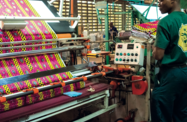
 How West Africa can position itself as a leader in textiles and apparel
How West Africa can position itself as a leader in textiles and apparel
What factors underpin West Africa's potential to be a regional leader in textiles?
CHRISTIAN SCHINDLER: West Africa has traditionally not been known as a destination for textiles or apparel manufacturing. Now that nearshoring is gaining traction in the industry, several factors work in favour of the region’s efforts to capture a share of China’s market share. The most evident of these is the abundance of cotton grown in the region. West Africa’s geographic location is attractive relative to destinations in Asia, given its proximity to the North American and European markets. Moreover, it offers advantageous trade terms under schemes such as the EU’s Generalised Scheme of Preferences and Everything but Arms, and the US' African Growth and Opportunity Act.
Labour costs in Africa are lower than in most Asian countries, especially China, and the continent has a large labour pool. These factors can be great assets if labour productivity can also become comparable. Energy costs are another criterion of competitiveness, especially in textiles. In Benin, for example, electricity costs are offered to industrial parks at $0.08 per KWh – a globally competitive rate. The region is also competitive in terms of other inputs, such as water.
When you invest in an industry it is important to utilise the latest technologies to be both energy efficient and productive. This can give West Africa a competitive edge, as more established players need a transition period to phase out their existing machinery and production methods in order to meet sustainability concerns.
In what ways do textile parks support industry development, and how can governments facilitate expansion?
SCHINDLER: Textile parks provide the main ingredients needed to attract investment into the industry. They offer high-quality, reliable and cost-efficient infrastructure – and in many cases a source of clean energy. They also feature administrative assistance facilities, and operators benefit from attractive investment incentives in terms of taxes and duties. Such factors encourage a wide variety of actors to establish operations, which in turn creates a cluster effect that supports value-chain development.
Education is the most important area for government intervention. Upskilling the workforce with the explicit intention of meeting the industry’s needs is critical to ensure steady growth. It is also imperative for employment opportunities that arise at all levels to be taken up by locals, rather than foreigners.
How quickly can West Africa develop its textiles industry?
SCHINDLER: There is confusion around the speed, scale and scope of the nearshoring trend. China is still responsible for more than 50% of global textiles and around 35% of apparel production. In this context, even a 5% market share is a significant volume that no country can take up overnight.
The relocation trend has been happening gradually since the beginning of the Industrial Revolution. Before the Second World War, 50% of global spinning production took place in Europe, mainly in the UK. Today, there is virtually none left in the UK and half of the global capacity is in China - demonstrating how far-reaching the shift can be and how long it can take.
There is more room for West Africa to grow in spinning or apparel. The remaining parts of the value chain will take time to develop. The textiles industry is capital-intensive, while apparel is labour intensive. Development typically starts either in spinning or in apparel because these are relatively easy to set up in terms of the technical know-how and capital needed. The bottleneck of the value chain is in weaving, finishing and dyeing. For example, Vietnam started with and is growing rapidly in spinning and apparel, but everything in the middle of the chain is not growing as fast. Bangladesh is still a major importer of Chinese fabric.
It is possible to grow cotton-based industries with political and regulatory will, and public and private sector collaboration. A prime example of this is Uzbekistan. In 2015 the country was exporting almost all of its cotton. It had been trying to develop a local industry but was blacklisted in the Western markets due to forced and child labour practices. However, a new president turned this situation around. All the cotton produced is now transformed locally and end products are exported to Western markets, owing to strides made in collaboration with the International Labour Organisation. With concerted efforts, West African countries could be even more successful.


 How West Africa can position itself as a leader in textiles and apparel
How West Africa can position itself as a leader in textiles and apparel